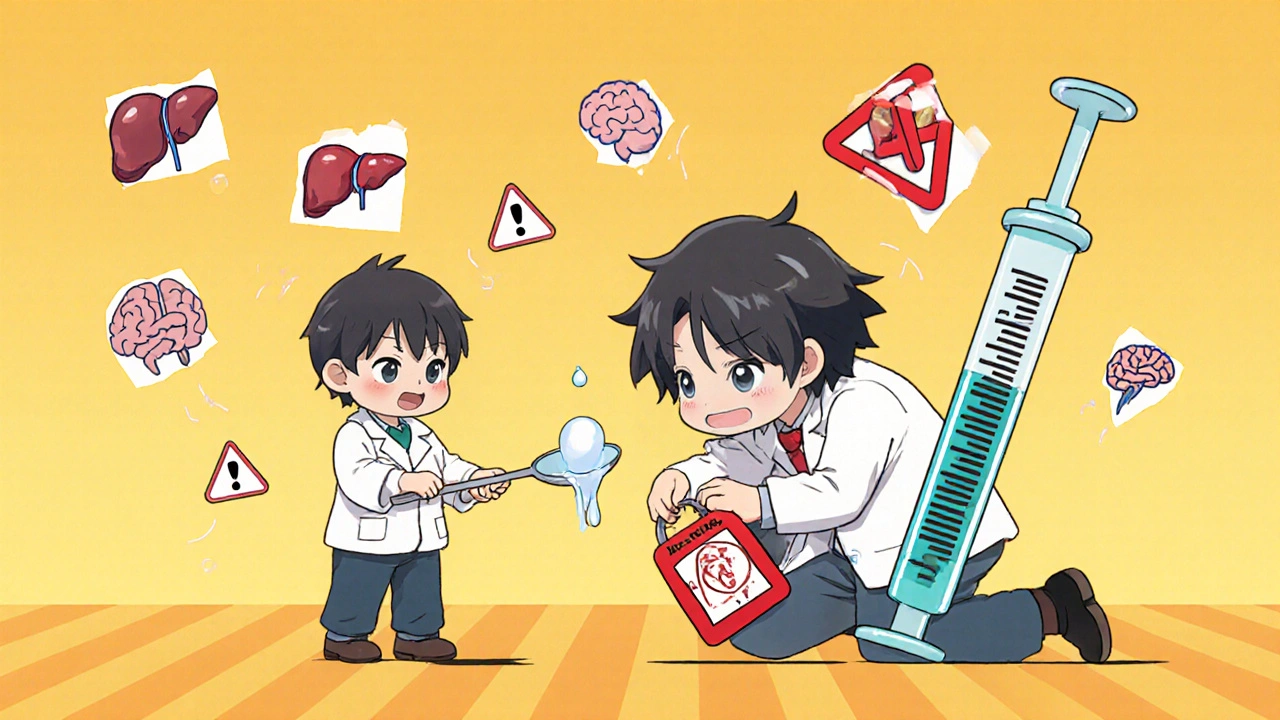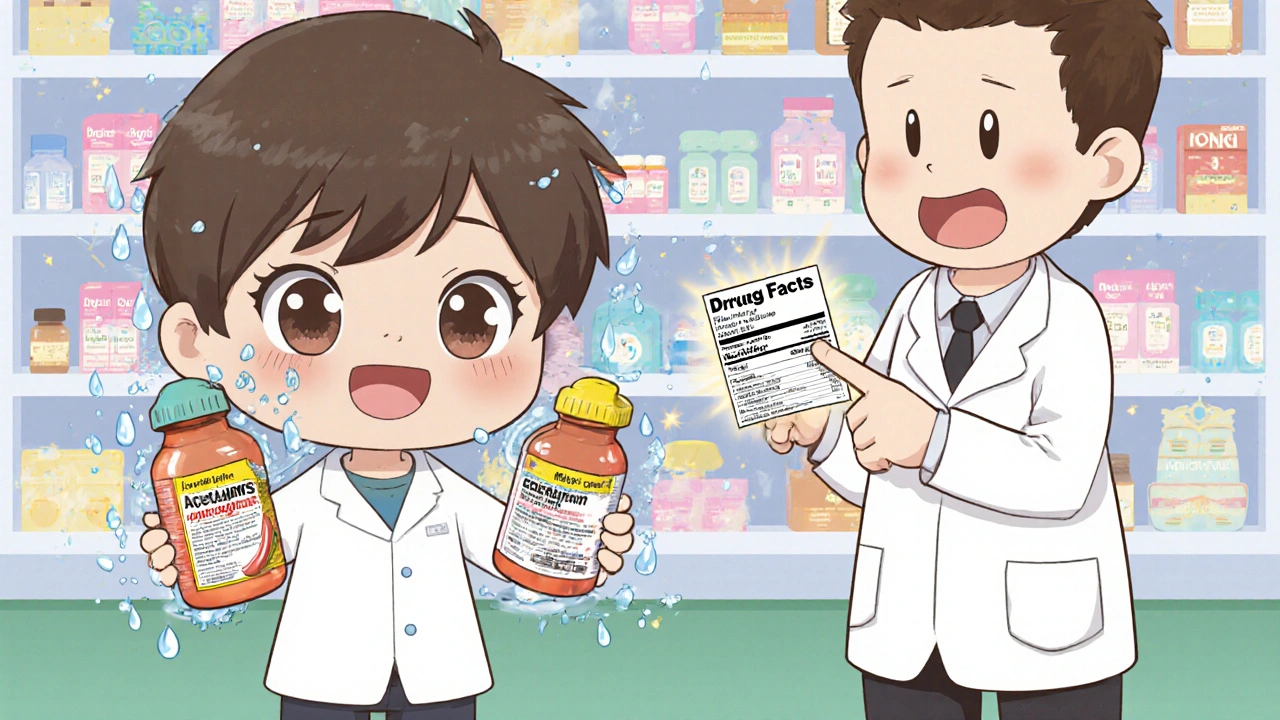Every year, millions of people walk into pharmacies looking for relief from a headache, a cold, or an upset stomach. They grab a bottle off the shelf, read the front label, and head out-no prescription needed. But here’s the thing: just because it’s available without a doctor’s note doesn’t mean it’s harmless. In fact, OTC medications are responsible for nearly 200,000 emergency room visits in the U.S. each year, mostly because people don’t know what’s actually in the bottle.
Read the Drug Facts Label-Every Time
The first thing you should do before picking up any OTC medicine? Stop. Look. Read. Not just the brand name or the promise of "fast relief." Look at the Drug Facts label. It’s required by the FDA on every single OTC product sold in the U.S. since 1999, and it’s the only part of the packaging you can truly trust.This label isn’t marketing fluff. It’s structured like a checklist:
- Active ingredients: The actual medicine. This is what does the work-and what can hurt you if you mix it wrong.
- Purpose: What the medicine is supposed to do (e.g., "pain reliever," "antihistamine").
- Uses: The symptoms it treats.
- Warnings: Who shouldn’t take it, what to avoid, and when to call a doctor.
- Directions: How much, how often, and for how long.
- Inactive ingredients: Fillers, dyes, flavors. Important if you have allergies.
People skip this part because it looks boring. But here’s the reality: if you don’t read the label, you’re guessing. And guessing with medicine is dangerous. The FDA says to read it every time-even if you’ve taken the same product before. Formulas change. Warnings get updated. A bottle you used last winter might now carry a new caution about high blood pressure.
Know Your Active Ingredients-Not Just the Brand
You don’t need to memorize chemical names, but you do need to know the most common ones-and what they do. Here’s the short list:- Acetaminophen (Tylenol): Good for pain and fever. But too much? Liver damage. The FDA says more than 56,000 ER visits a year are from acetaminophen overdose. And here’s the trap: it’s in over 600 products, including cold and flu remedies, sleep aids, and prescription painkillers like Vicodin. Taking two different products that both have it? You’re overdoing it.
- Ibuprofen (Advil, Motrin): Reduces inflammation, good for muscle aches, arthritis, menstrual cramps. But it can irritate your stomach or raise blood pressure. Avoid if you have kidney disease or are on blood thinners.
- Aspirin: Pain relief and anti-inflammatory, but also a blood thinner. Don’t take it if you’re on warfarin or have a bleeding disorder. Also avoid in kids under 16 because of Reye’s syndrome risk.
- Diphenhydramine (Benadryl): An antihistamine for allergies and sleep. Causes drowsiness. Dangerous if mixed with alcohol or sedatives.
- Pseudoephedrine: A decongestant. Can raise blood pressure and make your heart race. Avoid if you have heart disease or an enlarged prostate.
Here’s a simple rule: if you’re taking more than one OTC product, check the active ingredients. If they’re the same, you’re doubling up. That’s not better-it’s risky.
Don’t Use Kitchen Spoons to Measure Dose
"Take one tablespoon." Sounds easy. But a kitchen tablespoon? It can hold anywhere from 10 to 20 milliliters. The FDA tested this-kitchen spoons vary by up to 200%. That’s not a typo. One person might get the right dose. Another might get double-or half.Always use the measuring tool that comes with the medicine. A plastic cup with markings. A syringe. A dosing spoon. If it’s not there? Ask the pharmacist for one. They’ll give it to you free.
And don’t guess kids’ doses. "My child is small, so I’ll give half a dose." No. Children aren’t small adults. Their bodies process medicine differently. Use the weight-based chart on the label. If you’re unsure? Call the pharmacist. Don’t wing it.

Talk to the Pharmacist-Even If You Don’t Think You Need To
Pharmacists aren’t just the people who hand you the bottle. They’re trained to spot hidden dangers. They see what’s in your prescription list. They know what’s in your OTC cart. They’ve seen the mistakes before.Let’s say you’re on a beta-blocker for high blood pressure. You grab a cold medicine with pseudoephedrine. That combo can spike your blood pressure dangerously. Your doctor doesn’t know you bought that cold medicine. But your pharmacist? They’ll see it on your profile.
Same goes for diabetes. Decongestants can raise blood sugar. Antacids with aluminum or magnesium can interfere with kidney function in older adults. Pregnant women? Many OTC meds are off-limits. Even "natural" remedies like echinacea or ginger pills can interact.
Pharmacist advice is free. No appointment. No wait. Just walk up and say: "I’m looking for something for my cough, but I take [medication X] and have [condition Y]. What’s safe?" That’s what they’re there for. A 2022 study found pharmacist consultations cut OTC errors by 67%.
One Symptom, One Medicine
Multi-symptom cold remedies look convenient. "Fights cough, congestion, fever, and sore throat-all in one!" Sounds great. Until you realize you only have a cough. And now you’re taking an antihistamine and a decongestant you don’t need.That’s overmedication. And it’s common. The Ohio Department of Aging recommends: pick the medicine that treats only what you have. If you have a headache and nothing else? Take acetaminophen. Not the "full-spectrum cold relief" version that includes drowsiness-causing antihistamines.
More ingredients don’t mean better results. They mean more chances for side effects, interactions, and accidental overdose.

Know When to Stop-and When to Call a Doctor
OTC meds are for short-term relief. Not long-term fixes.Take these as red flags:
- Pain lasts more than 10 days.
- Fever doesn’t drop after 3 days.
- Symptoms get worse, not better.
- You feel dizzy, confused, or have chest pain after taking the medicine.
If you’re over 65, have chronic conditions like heart disease, kidney disease, or diabetes, or are pregnant-don’t wait. Talk to a professional before you even start. The Merck Manual says older adults make up half of all adverse drug reactions, even though they’re only 13% of the population. Why? Because they’re often on multiple medications, and their bodies process drugs slower.
And never share OTC meds. What works for your sister might be dangerous for you. A medication that’s fine for a healthy 30-year-old could be risky for someone with high blood pressure or liver issues.
Use One Pharmacy for Everything
If you use multiple pharmacies, your medication history gets split. One pharmacy sees your blood pressure pill. Another sees your OTC painkiller. Neither sees the full picture.Stick with one pharmacy. They’ll build a complete profile. They’ll flag interactions before you even walk up to the counter. It’s not just convenience-it’s safety.
Even if you’re only buying aspirin or antacids, use the same place. That way, if you ever need emergency care, your full medication list is already in the system.
Watch Out for New OTC Approvals
The FDA is approving more prescription drugs for OTC sale every year. In 2023, fluticasone furoate (Veramyst), a nasal spray once only available by prescription, became available over the counter for allergies.That’s good news-but it also means more people might use stronger medications without realizing the risks. Just because something moved from prescription to OTC doesn’t mean it’s harmless. Always read the label. Always ask the pharmacist.
And don’t assume "natural" or "herbal" means safe. Many herbal supplements aren’t regulated like OTC drugs. They can interact with your prescriptions, or cause liver damage. If you’re taking them, tell your pharmacist.
OTC medications are powerful tools. Used right, they help you feel better fast. Used wrong? They can land you in the hospital. The key isn’t avoiding them-it’s using them wisely. Read the label. Know what’s in it. Talk to the pharmacist. And never assume you know better than the science.
Can I take two different OTC medicines at the same time?
You can, but only if you check the active ingredients. Many OTC products contain the same medicine-like acetaminophen or ibuprofen. Taking two that both have it means you’re doubling your dose, which can cause serious harm. Always compare the Drug Facts labels before combining anything.
Is it safe to take OTC painkillers every day?
No. OTC pain relievers like ibuprofen and naproxen are meant for short-term use-usually no more than 10 days. Daily use can damage your stomach lining, kidneys, or liver. If you need pain relief every day, you need to see a doctor. There might be an underlying issue that needs treatment, not just masking.
What should I do if I accidentally take too much?
Call Poison Control immediately at 1-800-222-1222 in the U.S. Don’t wait for symptoms. Acetaminophen overdose, for example, can cause liver damage without obvious signs for 24-48 hours. If you’re outside the U.S., contact your local poison center or emergency services. Keep the medicine bottle handy-they’ll need the ingredients.
Are "natural" or "herbal" OTC products safer?
Not necessarily. Herbal supplements aren’t regulated like FDA-approved OTC drugs. They can contain hidden ingredients, vary in strength, or interact dangerously with your prescriptions. For example, St. John’s Wort can make birth control, blood thinners, and antidepressants less effective. Always tell your pharmacist if you’re taking herbal products.
Why does the label say "do not use if pregnant" if it’s OTC?
Because safety during pregnancy isn’t always proven. Many OTC drugs haven’t been tested in pregnant women, so manufacturers include warnings as a precaution. Even common meds like ibuprofen or certain antihistamines can affect fetal development. Always check with your doctor or pharmacist before taking anything while pregnant-even if it’s "just a cold medicine."
Can OTC meds interact with my prescription drugs?
Absolutely. Common examples: ibuprofen can reduce the effect of blood pressure meds; antihistamines can make sedatives stronger; decongestants can raise blood pressure if you’re on beta-blockers. Even aspirin can interfere with blood thinners. Always tell your pharmacist every prescription and supplement you take-they’ll spot risks you might miss.
Is it okay to use expired OTC medicine?
It’s not recommended. While some expired meds may still be safe, their potency drops over time. Pain relievers might not work as well. Antibiotic ointments could become ineffective. For life-saving meds like epinephrine auto-injectors, expired means useless. Always check the expiration date and dispose of old meds properly.
Choosing OTC medications isn’t about picking the cheapest or the most advertised. It’s about matching the right medicine to your symptoms, your health, and your other medications. The pharmacy isn’t just a store-it’s a safety checkpoint. And the pharmacist? They’re your best ally.
